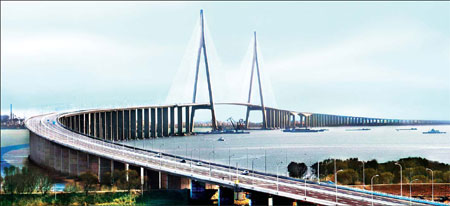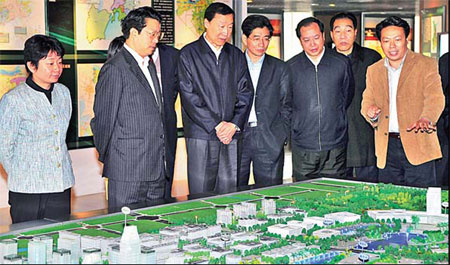Jiangsu governor paints blueprint for province
|
The 32.4-km Suzhou-Nantong Yangtze River Bridge, the world's longest suspension bridge, was opened on June 30, 2008. Xiao Yong |
China Daily had an exclusive interview with Jiangsu Provincial Governor Luo Zhijun to discuss the strategic programs for the development of Jiangsu province. The following is the Q&A of the interview.
Q: What is your primary task during your tenure in Jiangsu? Which major problems will you focus on and how will you solve them?
Luo: I believe that the foremost mission of the current provincial government is to further increase the present level of prosperity.
The current provincial government will focus on five major problems during its five-year tenure. The first is to make critical progress in economic development. With our industrial structure optimized, and planned development of urban and rural regions, we want to keep our annual growth above 10 per cent and hit a $8,000 per capita income level by the year 2012.
Second, along with continuous economic growth, we must take the lead in saving resources and protecting the environment. We must effectively solve key environmental problems, reduce energy consumption, effectively utilize resources and further reduce the discharge of pollutants.
Third, we must accelerate cultural development and progress in education, health and social welfare.
Fourth, we must raise and improve the standard of living in urban and rural areas. We are aiming for an average annual growth in disposable income for urban residents of 9 per cent or more per capita, more than 8 per cent for rural residents per capita.
Five, we must further reinforce the legal system and expand channels for democracy.
There are four areas in which the current government will make great efforts. First, to promote new thinking for innovation. Second, to open up avenues for innovation and development. Third, to set up mechanisms and systems helpful to scientific development. Fourth, to establish the image of a people-oriented, practical and incorruptible government.
Q: How will Jiangsu keep up the pace and sustainability of its economic development?
Luo: Over the past 30 years, Jiangsu has taken the lead in economic development. In the 1980s, township enterprises mushroomed in southern Jiangsu, leading to accelerated industrialization and urbanization. After 1990, southern Jiangsu and the Yangtze River regions developed an export-oriented economy. From 1978 to 2007, Jiangsu had an average annual growth rate of 12.6 per cent, which is 3 per cent higher than the national growth rate.
In order to maintain comprehensive, coordinated and sustainable development, we will focus on the following areas:
First, we will adjust the structure of our industry from processing to the manufacturing and service industries. We shall forge backbone industries of a trillion yuan based on information technology, equipment manufacturing and oil and chemical production. We shall beef up our emerging industries of energy, materials, and pharmaceuticals to a 100 billion yuan level. The manufacture of information technology products is currently the No 1 industry of the province, with revenues of 1.2 trillion yuan last year, accounting for 20 per cent of national sales revenues.
Second, we will accelerate the development of the service industry, giving priority to finance, logistics, exhibitions, R&D, commerce, and information technology, including software and outsourcing.
Third, we shall reinforce the support system for our infrastructure. We have built a 3,640-km express highway. Eight bridges spanning the Yangtze River have been built or are under construction. We shall focus on railways, airports and harbors in our future infrastructure work.
We'll intensify the development of innovation in science and technology and focus on the building of four national hi-tech industry bases, namely, Nanjing Software, Suzhou Electronic Information, Wuxi Micro-electronics and Taizhou Bio-pharmaceuticals.
Currently, Jiangsu has 12 state-level and 13 provincial-level development zones with 80,000 foreign-funded enterprises. We shall guide enterprises to make full use of imported technologies as well as increase investment in secondary development of these technologies. We shall enhance our advantage in human resources. Last year, the province budgeted 100 million yuan to bring in 108 senior professionals. This year, the budget has increased to 200 million yuan to attract leading and world-class engineering and technology professionals.
We are striving to do a good job in saving energy and reducing emissions, especially in key industries and enterprises. We are instituting pollution controls in our major river valleys and regions. We shall organize five major projects in energy saving, pollution control and emission reduction. Priority will be given to Taihu Lake, to guarantee safe drinking water for residents. We will use fiscal, tax, and price policies as incentives to promote energy saving.
Q: In terms of the development of the province, northern Jiangsu still lags behind. How can you attain even development of the regions within the province? And how can you avoid ecological problems in the process of developing northern Jiangsu?
Luo: Northern Jiangsu occupies 52 per cent of the total land mass of the province, and has 44 per cent of its population. Last year, the GDP of northern Jiangsu only accounted for 19.5 per cent of the province's GDP, and its per capita GDP was 29.6 per cent of that of southern Jiangsu.
Northern Jiangsu lags in terms of development for many reasons. The land in Northern Jiangsu is barren. There are frequent natural disasters. It is far from economically developed cities, unlike southern Jiangsu, which benefits from its proximity to Shanghai.
Since the mid-90s, Jiangsu has stressed simultaneous regional development as one of its five major strategies. In recent years, the Provincial Committee of the CPC and the Provincial Government has supported northern Jiangsu in six key areas.
First, in the past five years, provincial departments have invested 156.5 billion yuan in northern Jiangsu, including 66.6 billion yuan transferred from provincial coffers. Second, the province has implemented strategies for development of corridors along rivers, the coast, and the eastern part of Lanzhou-Lianyungang railway. Third, provincial departments, key enterprises, and cities and counties in southern Jiangsu supported 1,011 backward villages in northern Jiangsu in various ways, including sending personnel to hold posts in northern Jiangsu.
Fourth, northern and southern regions built development zones together. Fifth, more preferential policies for farmers and for supporting agriculture were provided for northern Jiangsu. The last was to encourage and support more professionals to go to northern Jiangsu. Last year, Jiangsu appointed 1,011 village-level officials through public recruitment mainly from middle and northern Jiangsu.
The poverty alleviation project entered its final phase to guarantee that 5.27 million poor people in the province with net incomes below 2,500 yuan, would rise above the poverty level within three years.
The development of northern Jiangsu will not be done at the expense of the environment. Environmental protection is a priority and strict standards will be instituted to prevent pollution.
Q: What new strategies has Jiangsu developed for its economy in terms of foreign trade and investment? What about international outsourcing services?
Luo: By the end of last year, $142.3 billion in foreign capital was invested in the province, nearly one fifth of foreign investments in China. More than 300 world-class multinational companies invested in Jiangsu. Our total foreign trade reached $349.7 billion last year, including $203.7 billion in exports. This was one sixth of the total of China's total foreign trade and exports last year.
Jiangsu will further innovate ways of using foreign capital, guiding more foreign capital to high-end manufacturing, R&D, the modern service industry, energy-saving industries and environmental protection industries, as well to the middle and northern parts of the province.
The province will strengthen exports, enhance brand cultivation, increase the proportions of independent-brand products, hi-tech products and products with high added value. We shall also encourage the import of advanced technical equipment and the energy resources that Jiangsu lacks.
The province will provide support for enterprises to establish production bases, resource bases, marketing networks and R&D centers in foreign countries.
Speeding up the development of the international outsourcing industry is one of the key strategies of the Provincial Committee of the CPC and the Provincial Government in order to forge the province into an important base for international outsourcing. At present, the province has three state-level service outsourcing bases, namely Nanjing, Suzhou Industrial Park and Wuxi Taihu Lake Reserve, and more than 1,000 outsourcing services companies of various types.
Q: As the highest administrative officer of a province of 76 million, what do you see as the most urgent problems of the common people?
Luo: Raising people's standard of living is a significant priority.
The first is to improve people's livelihood across the board. The province will provide ways for people to increase their assets through investments and financing, speed up the establishment of a social security system covering both the urban and rural areas, and provide high-quality public service and a stable social welfare system for all people in the province.
In improving people's livelihoods, we need to address key problems, which includes helping the poor find employment, and providing financial support for students from poor families, medical care, housing and help for the elderly.
The government will increase investment in healthcare, by improving medical facilities, especially in rural areas and communities, and push for basic medical insurance.
The province will establish a housing system for low-income households in urban areas, by adding more low-rent housing and expand the construction of affordable housing. With the advent of an aging population, the province will pay more attention to services for senior citizens and speed up the construction of facilities for the elderly, such as the elderly housing.
We must make more efforts to establish a long-term system, and will also set policies and measures to guarantee a welfare system for low-income people.
|
Governor Luo Zhijun (third from left) inspects the urban planning in Wuxi on March 29. Xiao Yong |
(China Daily 08/07/2008 page36)










